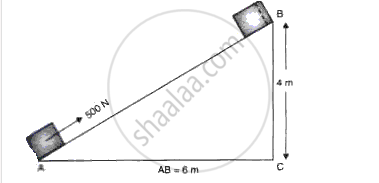Advertisements
Advertisements
Question
A vessel containing 50 kg of water is placed at a height 15 m above the ground. Assuming the gravitational potential energy at ground to be zero, what will be the gravitational potential energy of water in the vessel? (g = 10 m s-2)
Solution
Mass of water, m = 50 kg
Gravitational force F = mg = (50 × 10) N
Height, h = 15 m
Gravitational potential energy = mgh
= 50 × 10 × 15
= 7500 J
APPEARS IN
RELATED QUESTIONS
Power spent by a body depends on the time for which it does work.
State two factors on which the work done on a body depends.
How is work related to energy?
State two disadvantages of producing hydroelectricity.
Define the term 'work'. Write the formula for the work done on a body when a force acts on the body in the direction of its displacement. Give the meaning of each symbol which occurs in the formula.
Why is the work done on an object moving with uniform circular motion zero?
The work done on an object does not depend on ______.
What is the relationship between Nm and dyne cm?
Give two examples of couple action in our daily life.
Explain the difference between a uniform linear motion and a uniform circular motion.
A boy does work when he pushes against a brick wall. (yes/no).
Nm is the unit of .......
What is the work done when the object acted upon by a force remains at rest?
(a) Define power and name its unit.
(b) A girl weighting 50 kg climbs up 60 steps each of 20 cm height in 5 minutes. Calculate the power developed.
A block of mass 20 kg is pulled up a slope (fig.12) with a constant speed by applying a force of 500 N parallel to the slope. A and B are initial and final positions of the block.
(a) Calculate the work done by the force in moving the block from A and B.
(b) Calculate the potential energy gained by the block.

What do you understand by the term energy? Is energy a scalar or vector? How is the energy possessed by a body measured?
One labourer carried four pans of road metal through a distance of 100 metres. If he carries two pans of road metal through a 200 metre distance ______ work will be done.
A uniform chain of length 2 m is kept on a table such that a length of 60 cm hangs freely from the edge of the table. The total mass of the chain is 4 kg. What is the work done in pulling the entire chain on the table?
